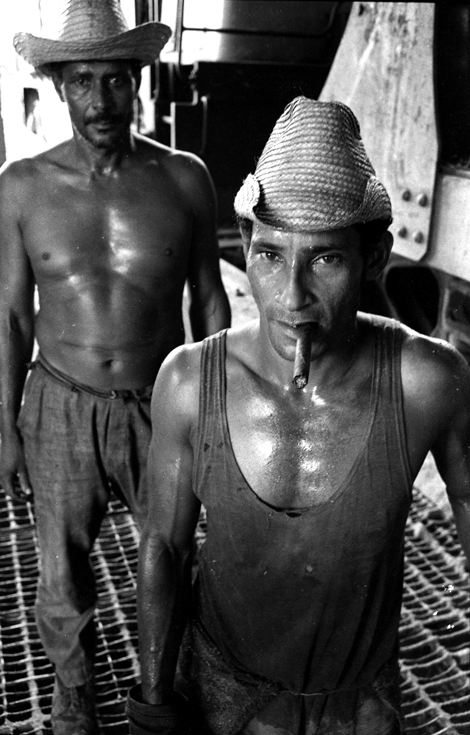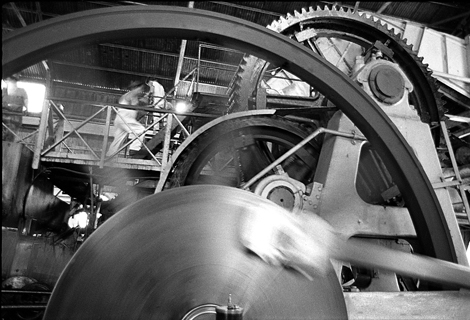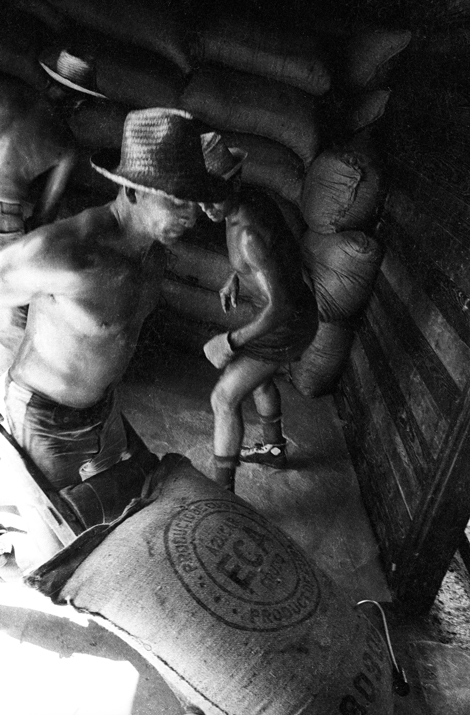Americans who know Cuba only through movies (God-father 2, Before Night Falls) and familiarity with a few star Cuban artists (Wifredo Lam, Ana Mendieta) are guilty of the oxymoron of mainland insularity, a product of Cold War tensions that arose in 1959 with the revolution and have lingered on twenty-five years since the 1989 fall of the USSR.
The photographs of De la Uz, a well-known Cuban documentarian photographer, filmmaker, and critic, include 27 of the black-and-white silver gelatin photos that he took in the 1960s and ’70s (along with recent digital enlargements) to document the sugar cane industry. Sugar cane was Cuba’s main export during the three decades when the country was a well-subsidized Soviet ally and client state. The prospect of propaganda raises hackles even now in American viewers, but these are sober images of an industry before mechanization in the field with none of the grinning, marching peasant worker about them; indeed, it is entirely conceivable that the images could be recontextualized as anti-collectivist, considering how grindingly hard the work appears. Where one viewer can interpret an ennobling of manual labor, another may flinch at the reality of agricultural life.
De la Uz, as a child of the Revolution (born in 1944, he was 15-years-old when it happened), focused on the worker as the foundation of the socialized national economy; his commitment to reality, however, and his interest in interpreting that reality, counterbalance each other.
According to an interview with the artist in the Havana Project, De la Uz works with minimal equipment in order not to be intrusive, tries “to be polite” and to have “a sense of humor.” De la Uz’s respectful philosophy is discernible in his 1970 “Zafra” series, named after the sugar cane harvest by machete-wielding cutters from January through May each year. The extraction of the familiar white refined sugar from cane stalks involves steam-turbine-powered mills with blades, lime and sulfur dioxide. Zafra 70 4 and Zafra 70 10 depict a worker on a catwalk, dwarfed by wheels and gears in the surrounding shadows. In four photos of macheteros, the workers are silhouetted against the sky, their blades and cane stalks akimbo, while two photos of estibadores (stevedores) show men loading burlap bags of sugar in a darkened shed, the light glistening on their sweaty bodies. Women, too, appear—one cooking at a grill amid clouds of steam in Cocina Viega (Old Kitchen) (1970), and another, coquettishly adjusting her hair, in Mujer Enfangada (Women Covered with Mud) (1970). In others, young men, temporarily idle, gaze out at us, impassively.
Lately the western world seems to have developed a disdain for manual labor; even in the art world we have largely adopted the bottom-line values of Wall Street, eschewing craft and discipline, and valorizing hype. Glimpses of the realities behind industrial products as in de la Uz’s work may not be glamorous, and even may smack of worker-paradise propaganda to some, but they’re a welcome counterbalance to the incessant fashions and fantasies of the media world.






















Excellent!
Thanks DeWitt.
Henry
How is Enrique doing these days? I gave him a Pentax 6×7 and wonder what he was able to do with it.I enjoyed meeting him and his wife in Havana. Thanks for highlighting his work.
Alan